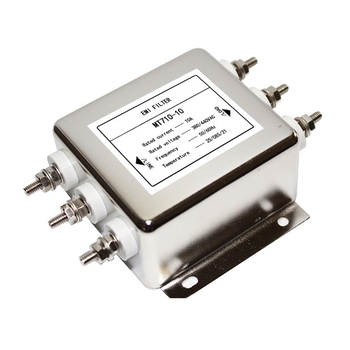What is the Purpose of a Power Line Filter?
Definition & Purpose
A power line filter is an electrical apparatus that efficiently filters that frequency in a power line as well as any other frequencies. The purpose of a power line filter is to access a power line filter in the power line and receive a power signal of a particular frequency or delete a power signal after a particular frequency.
It is a passive two-way network with the power supply at one end and the load at the other. As a result, it is an impedance adaptation network. Because of the characteristics of the power port's electromagnetic interference and design, power line filters for noise suppression are typically low-pass type, which is important for electronic products because electromagnetic noise causes interference from other equipment with electronic products.
Therefore, the power line filter's primary function is to suppress electromagnetic noise, which has two main categories of influence.
- Emissions: are produced by the device, the effect of the power supply, or other devices to reduce the noise to regulations (such FCC part 15), which permit the value of the following, such as the noise produced by the switching power supply.
- Immunity: This aims to lower noise levels in equipment to a point where it prevents anomalous behavior, such as the instrument used in radio transmission equipment.
The following two categories can be used to separate the noise that the power line filter is intended to reduce.
- Common mode: Noise from the power line to the ground can be characterized as noise that is identical in two (or more) power lines.
- Differential mode: the noise that exists between two power lines.
The capacity of the same power line filter to suppress common mode noise and differential mode noise will be different, and examples will often utilize the frequency that corresponds to the spectrum's suppression level (expressed in dB). The differential mode interference signal and common mode interference signal can be used to characterize any high frequency conducted nuisance signal on the power line. Differential-mode interference, which is symmetrical interference, travels between the two transmission conductors, whereas common-mode interference, which is asymmetrical interference, travels between the transmission conductors and ground.
How to choose a power line filter?
As a result, in order to evaluate a power line filter's merits, one must be aware of its performance indications. These indicators include the power line filter's rated voltage, rated current, leakage current, insulation resistance, withstand voltage value, operating temperature, insertion loss, and others. One of the most significant indicators is insertion loss, which is typically displayed in decibels or frequency characteristic curves and represents the cost of power line filter performance. It describes the filter access line that runs from the power end of the power ratio or port voltage ratio to the load end before and after the test signal. The ability to suppress interference is stronger the higher the decibel number.
Furthermore, we should carefully evaluate the quantity of phases, rated voltage, rated current, size of the leakage current, certification, volume and shape, insertion loss, etc. while buying a power line filter. In addition to these, the object of use must also be taken into account when selecting a decent power line filter. In addition to these, we must also take into account the intended purpose when selecting a power line filter. For instance, some power line filters are military grade, others are industrial grade, some are for home equipment, some are for medical equipment, etc.
Welcome to ATO online store, where you can get a power line filter for a reasonable price that is nevertheless of great quality.

